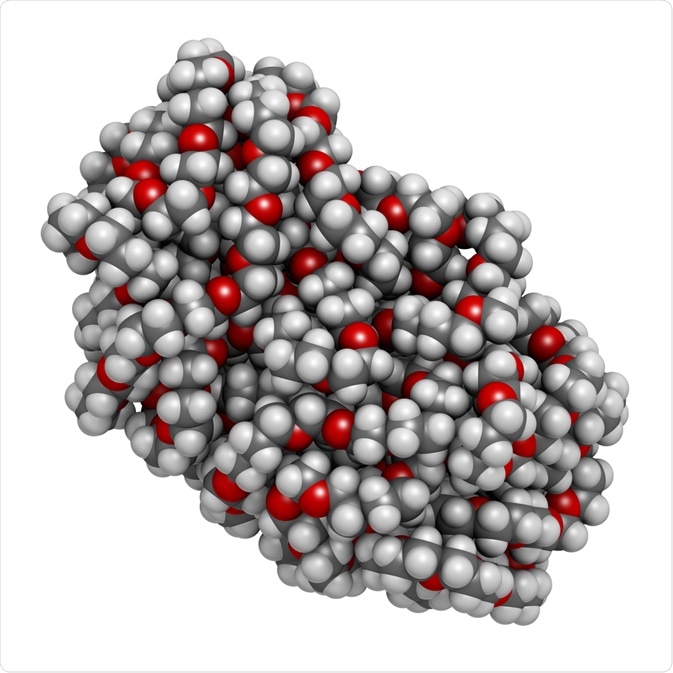What is Polyethylene Glycol (PEG)?

Polyethylene glycol (PEG) is a biocompatible, synthetic, hydrophilic polyether compound that has many applications, mostly in the medical industry, but also in the chemical and industrial sectors. The structure of the compound is known as H−(O−CH2−CH2)n−OH.

Image Credit: StudioMolekuul/Shutterstock.com
The synthesis of PEG is done by polymerizing ethylene oxide, the main ingredient in antifreeze, using a ring-opening technique, which allows for PEGs of a range of molecular weights and molecular weight distributions to be constructed. This range in weights is what makes it suitable for several uses.
Characteristics of polyethylene glycol
While varying the molecular weight of PEG can have slight effects on its characteristics, mostly on its shape and physical appearance, many characteristics define PEG. It is non-toxic, colorless, inert, odorless, and non-volatile. Also, it is incredibly soluble in water, and organic solvents such as benzene, carbon tetrachloride, and chloroform.
Creating PEG substances of different molecular weights relies on constructing PEG with different length chains. Larger PEG molecules have a greater number of repetitions of their structure compared with smaller ones.
Below, we discuss how PEG is applied in the two main industries that it is active in.
Uses in the medical industry
PEG has a vast number of applications in the medical industry, and the list continues to grow. Due to its non-toxicity and high solubility, it lends itself to many pharmaceutical and biomedical applications.
To begin with, possibly the most common application of PEG in the medical industry is its use in laxatives. Because PEG can apply osmotic pressure, it can draw water into the waste matter, providing a laxative effect.
In a similar scenario, PEG is often utilized during whole bowel irrigations to prepare the gastrointestinal tract for investigation or surgery. PEG is also used in many pharmaceutical creams, ointments, and medical solvents.
Peptides, proteins, or oligonucleotides are used as drug targets for various illnesses. PEG can be used to bioconjugate itself to the target, by coupling itself with the target molecule to optimize the pharmacokinetic properties of drug treatment.
PEG can be used as an inactive substance that acts as the vehicle for a drug. The process of drug delivery relies heavily on PEG because the compound can link together antibody-drug conjugates (ADCs). It can also be used to improve systematic drug delivery by adding it as a surface coating on nanoparticles. PEG can also be used to slow the clearance of coated proteins from the blood in biomedicines.
PEG hydrogels are also used in drug delivery, as well as in tissue engineering. PEG hydrogels are polymer networks that are created by crosslinking reactive PEG end groups, resulting in gels that are resistant to protein biodegradation and adhesion. These properties are beneficial to tissue engineering and drug delivery.
In vitro assays have also become dependent on PEG, using it to mimic crowded cellular conditions to allow researchers to research intracellular environments outside of the body.
Protein analysis is another biomedical area that utilizes PEG, which is used in several applications in this field. The compound is used as a precipitant for DNA isolation as well as for cell crystallization, helping to reveal the atomic structure of proteins.
Gene therapy uses PEG to coat vectors, for example, viruses, to protect them from being inactivated by the immune system, and to de-target them in the organs, preventing their potentially toxic effect.
PEG is also particularly essential in blood banks, where it is used to enhance the salience of antibodies and antigens.
The future is likely to see more medical applications of PEG develop. One current focus of research in this area is exploring how PEG can be used in the spinal cord and peripheral nerve injury, by employing it to fuse axons that have been compromised.
Uses in the chemical industry
PEG has many roles in the chemical industry, which also cross over into applications in other industries. Firstly, it is well known for its use as a binding and dispersing agent, as it can improve the separation of particles and prevent clumping.
Also, as PEG has hydrophilic properties, it has found a role in preventing the non-specific sticking of proteins in studies using single-molecule fluorescence.
Also, because the compound is non-toxic and recognized as safe by the FDA, it has been able to be used in numerous coatings that enable lubrication in various scenarios.
Applications in preservation have also found a use for PEG, which is now employed to prevent and slow the damage and shrinkage of wood that has been submerged. It was used to preserve the Vasa warship in Stockholm, replacing the water trapped within the wood to prevent warping and shrinking.
Another famous case that has appropriated PEG is the restoration and preservation of the Terracotta Warriors. A PEG preservative was specially developed to preserve the colors painted onto the Terracotta army, which date back to the Qin Shi Huang Di dynasty.
As in the medical industry, the chemical applications of PEG will likely continue to grow.
Sources:
Ganji, M., Docter, M., Le Grice, S. and Abbondanzieri, E. (2016). DNA binding proteins explore multiple local configurations during docking via rapid rebinding. Nucleic Acids Research, 44(17), pp.8376-8384. https://www.ncbi.nlm.nih.gov/pmc/articles/PMC5041478/
Kean, S. (2019). Chemical Hope. [online] Science History Institute. Available at: https://www.sciencehistory.org/distillations/magazine/chemical-hope [Accessed 24 Dec. 2019].
Tum.de. (2019). Conservators preserve the paint layers of the Terracotta Army. [online] Available at: https://www.tum.de/nc/en/about-tum/news/press-releases/details/32290/ [Accessed 24 Dec. 2019].
Last Updated: Feb 4, 2020

Written by
Sarah Moore
After studying Psychology and then Neuroscience, Sarah quickly found her enjoyment for researching and writing research papers; turning to a passion to connect ideas with people through writing.
Source: Read Full Article



